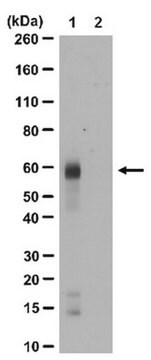ABE26
Anti-acetyl-c-Myc (Lys323) Antibody
from rabbit, purified by affinity chromatography
Synonim(y):
Myc proto-oncogene protein, Class E basic helix-loop-helix protein 39, HLHe39, Proto-oncogene c-Myc, Transcription factor p64, c-MYC
About This Item
Polecane produkty
pochodzenie biologiczne
rabbit
Poziom jakości
forma przeciwciała
affinity isolated antibody
rodzaj przeciwciała
primary antibodies
klon
polyclonal
oczyszczone przez
affinity chromatography
reaktywność gatunkowa
mouse, human
reaktywność gatunkowa (przewidywana na podstawie homologii)
rhesus macaque (based on 100% sequence homology), chimpanzee (based on 100% sequence homology)
metody
western blot: suitable
numer dostępu NCBI
numer dostępu UniProt
Warunki transportu
wet ice
docelowa modyfikacja potranslacyjna
acetylation (Lys323)
informacje o genach
chimpanzee ... Myc(464393)
human ... MYC(4609)
mouse ... Myc(17869)
rhesus monkey ... Myc(694626)
Opis ogólny
Specyficzność
Immunogen
Zastosowanie
Peptide Inhibition Assay Analysis: A representative lot was used by an independent laboratory in HEK293T cells co-transfected with mouse wildtype c-Myc and P300. (Image courtesy of Dr. Ernest Martinez, Department of Biochemistry, University of California at Riverside.)
Epigenetics & Nuclear Function
Transcription Factors
Jakość
Western Blot Analysis: 0.2 µg/mL of this antibody detected c-Myc on 10 µg of transfected HEK293T cell lysates.
Opis wartości docelowych
Postać fizyczna
Przechowywanie i stabilność
Komentarz do analizy
Transfected HEK293T cell lysates
Inne uwagi
Oświadczenie o zrzeczeniu się odpowiedzialności
Not finding the right product?
Try our Narzędzie selektora produktów.
Kod klasy składowania
12 - Non Combustible Liquids
Klasa zagrożenia wodnego (WGK)
WGK 1
Temperatura zapłonu (°F)
Not applicable
Temperatura zapłonu (°C)
Not applicable
Certyfikaty analizy (CoA)
Poszukaj Certyfikaty analizy (CoA), wpisując numer partii/serii produktów. Numery serii i partii można znaleźć na etykiecie produktu po słowach „seria” lub „partia”.
Masz już ten produkt?
Dokumenty związane z niedawno zakupionymi produktami zostały zamieszczone w Bibliotece dokumentów.
Nasz zespół naukowców ma doświadczenie we wszystkich obszarach badań, w tym w naukach przyrodniczych, materiałoznawstwie, syntezie chemicznej, chromatografii, analityce i wielu innych dziedzinach.
Skontaktuj się z zespołem ds. pomocy technicznej







